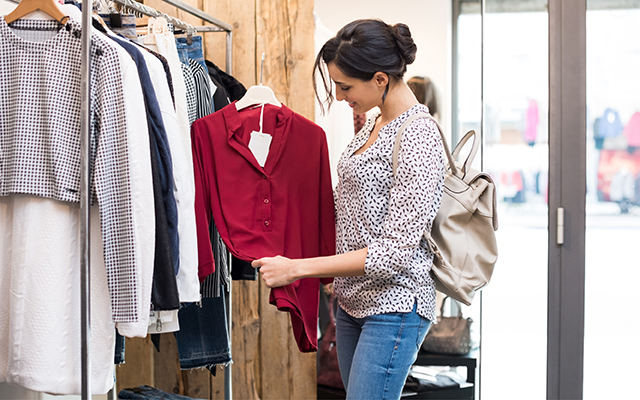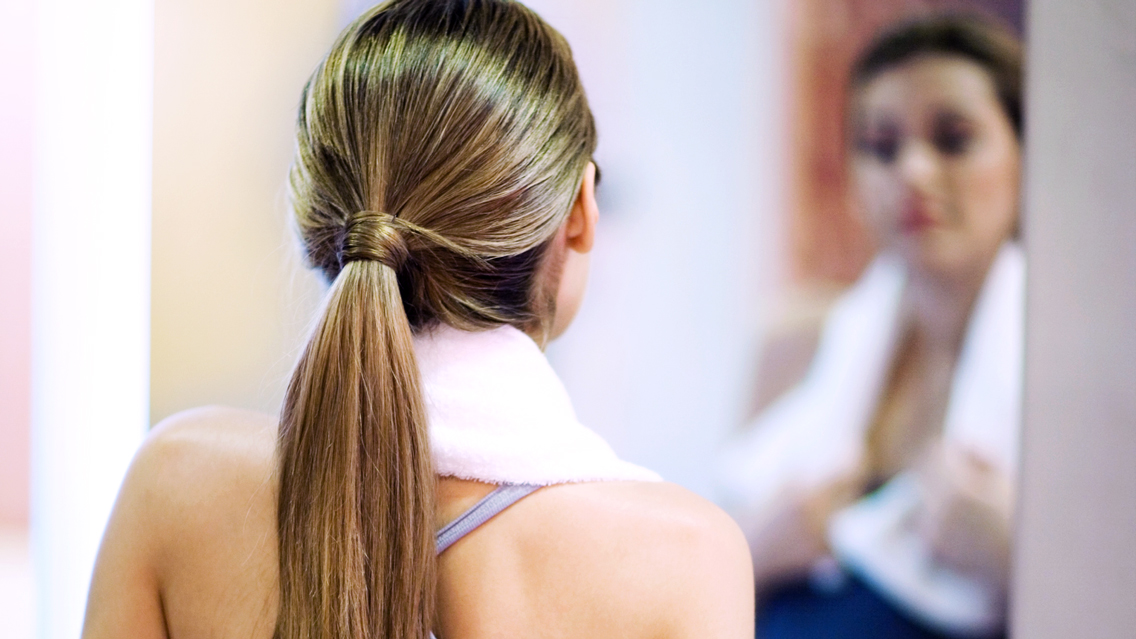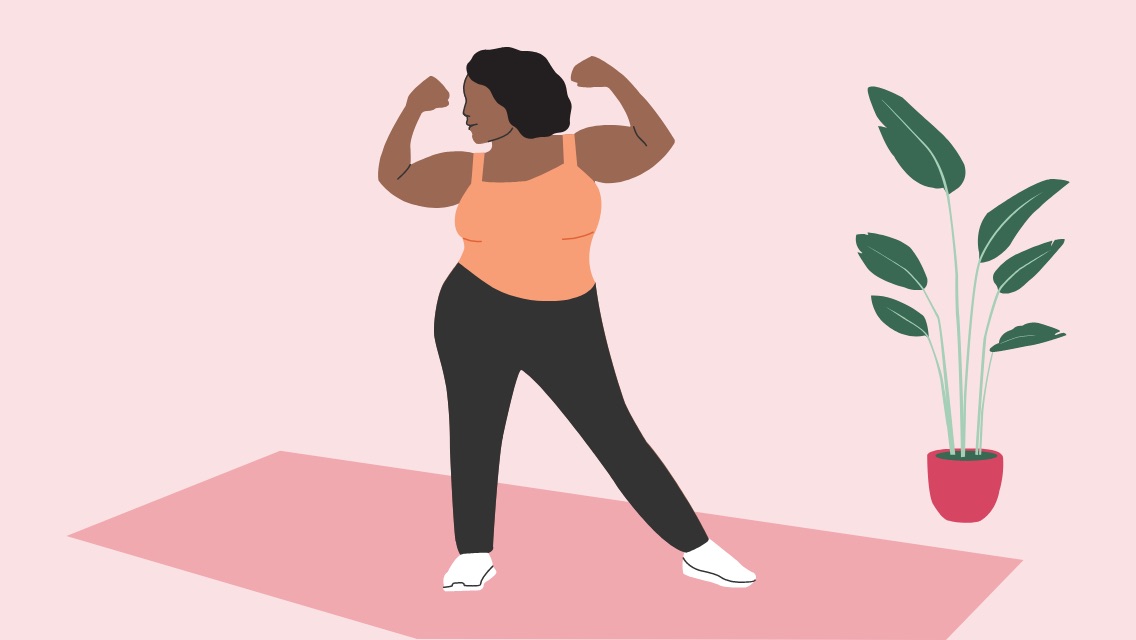When Casey Helbling went to get his driver’s license renewed, the woman behind the counter did a double take. The 36-year-old software engineer and father of three had lost more than 40 pounds since his last visit to the Minneapolis DMV, and the clerk had trouble believing he was the same man in the license photo.
After months of exercise, triathlon training and healthier eating, Helbling’s physique had slimmed dramatically. As his body changed, his clothing needed shifting as well — but it took him awhile to come to terms with that.
“I dragged my feet on buying new clothes at first, mostly because I’d lost weight before and regained it pretty quickly,” Helbling says. “I guess I was in denial that I had actually changed my life and wasn’t going to be overweight anymore. During that six months of holding out, I looked terrible.”
Once Helbling accepted his new, fitter reality and started shopping, his work clothes were the first things needing a promotion. “I had tons of button-down dress shirts that I was just swimming in. I needed a whole set with my new measurements,” he says. Going from extra-large to medium also meant that he needed to buy everything from jeans and T-shirts to suits.
As Helbling upgraded his closet, his self-image shifted accordingly. “Ditching my old belt — since I got to the last hole and needed an entirely smaller size — was a pretty great day,” he recalls. “Wearing clothes that fit well gave me increased confidence, both in my body and in general.”
Jennifer Baumgartner, PsyD, psychologist and author of You Are What You Wear, asserts that the way we dress is closely tied to how we feel, particularly when our bodies are changing as the result of weight loss or improved fitness.
“Just like any other behavior — relationship behavior, sleep behavior, eating behavior — what we wear can be an indicator of what’s going on internally,” she says. “There’s a constant conversation between the inside and the outside.”
Whether you have a new physique to reveal, are halfway to your goal or just starting your journey to better health, upgrading what you wear can help you improve not just your self-confidence and self-esteem, but also the quality of your daily experiences.
There’s science to support the notion that we benefit from dressing for the body and fitness level we want to have. I’ll get to that in a moment. For me, though, the most convincing evidence has come from my own personal experience.
Dressing Your Future Self
Last summer, when my sister, Jen, tried to convince me to join her for an easy run around the neighborhood, I emphatically declined. “I am not a runner,” I said. “Sure you are,” she replied. “You just don’t have the right clothes for the job. If you look like you know what you’re doing, you’ll feel like you know what you’re doing.”
I was dubious. Although I had recently recommitted to healthy eating and yoga, I hadn’t moved faster than a brisk walk since my high school gym teacher made me take the President’s Challenge Physical Fitness Test.
Still, I decided to test her theory. At a consignment store, we found hot-weather running capris and various comfortable tops; at a shoe warehouse, we scored lightweight running shoes; and at a discount store, we picked up the necessary sports bras and socks.
It turned out that Jen was right: When I put on the full ensemble, my muscles weren’t any more toned than before, but I felt a whole lot more like a runner — enough that I was willing to give it a try. That day, on my first-ever jog, I was able to (almost) keep up with my sister.
And a year later, that workout “costume” still gives me confidence when I catch my reflection in a coffee-shop window on mile four.
In a study published in the Journal of Experimental Social Psychology, scientists from Northwestern University’s Kellogg School of Management discovered that what we wear has a surprising impact on how we think. Researchers Hajo Adam, PhD, and Adam D. Galinsky, PhD, call the phenomenon “enclothed cognition.”
In one experiment, 74 college students were asked to wear either a doctor’s coat or a painter’s coat (which were the same white coat, different only in name) or to simply look at a doctor’s coat while performing a series of mental tests. Only those who wore the perceived doctor’s coat increased their test scores and showed significantly heightened attention levels.
Two important factors underlie the results, says Adam: the symbolic meaning of the clothes and the physical experience of wearing them. It turns out that merely seeing or thinking about a physician’s crisp, white coat won’t improve your cognition as much as feeling that coat around your shoulders will.
How can we harness the power of enclothed cognition in our everyday lives? “Keep in mind the characteristics that you associate with a piece of clothing,” Adam says. “For example, if you wear a tailored suit or dress, you might feel more empowered and confident, and perform better at work. If you wear some specialized fitness gear, it might make you feel more energized to work out harder.”
Similarly, if you are feeling stuck with a body (or body image) you’d rather say goodbye to, wearing body-positive (versus body-hiding) clothes can give you a powerful nudge. If you’re like me, a head-to-toe wardrobe change might even help you reach a fitness goal (or try on an athletic identity) that previously felt out of reach.
Halfway There and Nothing To Wear
If your body has started changing for the better, you’re likely enjoying more energy, improved self-esteem and some very nice compliments. There’s just one problem: None of your clothes fit.
This transitional time can be both victorious and disheartening, say Autumn Starks and Jennifer Trudeau, two friends in a Chicago weight-loss group who are going through this phase together.
“Everything is too big. Especially expensive things like jeans and bras, where fit is really important,” says Starks, who has lost 30 pounds so far.
“When you want to look as good as you feel, putting on ill-fitting clothes can be discouraging,” notes Trudeau.
But shopping for an in-progress body can also be challenging, both because of the cost and because you might feel anxious that it could work against you or jinx your success.
What’s important now is not to get stuck in your former reality. This in-between period, says Baumgartner, is the perfect time to start cleaning out your closet and purchasing some fill-in pieces. “When people are losing weight, there’s often a fear that they’re going to return to what they were,” she explains, “so they hold on to their old clothes. But getting rid of your old wardrobe will help you see that you’re moving forward.”
Updating even a few key items can also be a powerful acknowledgment that you value yourself. “The external is an extension of the internal,” Baumgartner emphasizes. “Demonstrating that you’re worth taking care of externally shows that you’re worth taking care of internally. So dress well now. Don’t wait to feel good about yourself until you’ve reached a goal.”
When looking for transitional pieces, you want to spend your dollars wisely. This is a great time to build your thrifty-shopping skills while expanding your fashion confidence.
Visit local consignment stores to find in-between items. (You may also be able to consign some of the higher-quality clothes you’ve just cleared from your closet to make a few extra dollars for your clothing budget.) Or shop outlet malls or inexpensive “fast-fashion” stores — retailers, like H&M, that create inexpensive, up-to-the-minute collections each season. Women can also investigate rental sites like RentTheRunway.com or LeTote.com for special-occasion clothes that can be worn once and then returned.
Whatever your shopping strategy, strive to buy pieces that speak to your emerging sense of style and confidence, rather than settling for purely functional items that leave you feeling dowdy. This could make a difference not just in how you look, but in how motivated you feel to continue your body-transforming pursuits.
Karen Pine, PhD, of the University of Hertfordshire’s School of Psychology, interviewed 100 women and found that they were 10 times more likely to put on a favorite dress when they were feeling happy versus depressed. Conversely, when feeling depressed, they were more likely to wear a baggy top.
From her research, Pine interprets that the clothes we wear can improve our mood. “Just like how putting on a smile can boost one’s feeling of happiness, putting on an outfit that makes the person feel they look good has several effects,” she says. “It boosts self-image, it gets a more positive reaction from others, and it may trigger reminders of happy times.”
The Style of Success
Long after you’ve accomplished your fitness or weight-loss goals, you may still find your self-image is in transition. During this “move-in period,” you may not really have a sense of what clothes are right for you.
So before you hit the mall, take some time to imagine and envision — with fresh eyes — the person you choose to be going forward, suggests Baumgartner. “I often hear people say, ‘I lost all this weight, but I still feel like the same person.’ You have to acknowledge that you’re now different — not just externally, but internally.”
Journaling can be a great way to process the physical and psychological changes weight loss brings. You might even make a vision board to help clarify and document your new look, body image and attitude. (For more on this practice, see ELmag.com/visionboards.)
In the meantime, be prepared for the possibility that some friends and family members may struggle to integrate and accept the changes they see in you. Your transformation and evolving style might trigger jealousy or judgments that surprise you. And hard-to-interpret comments like, “Well! Look at you!” can trigger embarrassment or subconscious beliefs that make you think you don’t deserve or can’t pull off this new look.
Here’s the good news: Seeing you in new clothes can help others adjust to the change in your appearance — and, in turn, wearing them can help you adapt to your new self-image. Pine’s research shows that clothing is especially key in forming first impressions. When more than 300 study participants were asked to review photographs of a man dressed in either a sharp, custom-fit suit or an ill-fitting, off-the-rack suit and then make a snap judgment about him, they overwhelmingly favored the man in the tailored suit. After a mere three-second exposure, he was ranked as more confident, more successful, more flexible and a higher earner.
“Just as costumes are used to help the audience identify a new character, clothing can be used to help friends and family accept a new you,” Baumgartner says. Projecting an image that people admire can go a long way in affecting how we see ourselves, too, further raising our own levels of self-assurance.
Once you’ve got a better sense of your new self, get ready to restock your closet. First, consider what garments are appropriate for your lifestyle, body and age. Then, make a list of the staples you need to replace. Amy E. Goodman, author of Wear This, Toss That! (Atria Books, 2011) offers this golden rule when shopping for any new item: “Make sure it fits well, that it serves a purpose, and that you can envision yourself wearing it in at least two to three circumstances.”
Wardrobe consultant Christine Clark recommends developing a personal sense of style by coming up with five or six standard looks or “uniforms” that you return to again and again. For example, jeans with a button-down shirt and vest could be a uniform for men; a monochromatic sweater and pants with a bright-colored accessory could be one for women. “If you’ve identified a look you like, you can grab it out of your closet and go,” Clark says. “You don’t have to think about it.”
If you can afford it, working with a wardrobe or image consultant can be hugely helpful. If not, consider working with a department store’s personal shopper or taking a fashion-savvy friend shopping with you to serve as your informal stylist. “Some people only know how to buy clothes for their old body type, and they usually end up with things that are entirely too big,” Goodman says.
Whatever you do, don’t underestimate the power of a wardrobe upgrade. While clothes don’t make the man or woman, they can make a difference in your confidence, performance and happiness — from the outside in.
Starting Out
This is your motivation period, so upgrade your workout gear,” advises Goodman. Invest in at least one brightly colored shirt and some workout pants that are tailored to your frame, she suggests. You want to wear something that “will make you see a difference in the mirror when you pause between reps.” Here are her other shopping suggestions, for workouts and everyday life, at this stage:
Buy: Shop for good shoes made for your type of exercise (e.g., walking, running, resistance training) and functional workout gear made with stretchy, breathable fabrics. Now is also the time to buy accessories, such as a cool watch or a distinctive briefcase or hand-bag, which will both fit and suit you down the road.
Beware: Since your body is going to be changing, avoid buying lots of expensive new garments in your current size. Instead, if you’re going to a wedding or party, make something in your current wardrobe work and spice it up with a new tie, purse or other affordable accessory.
Bridging the Gap
Update the essentials of your wardrobe so that you can see your progress,” advises Goodman. “This is such an important motivator. Witnessing how your body is evolving encourages you to keep up the good work.”
Buy: Smart midstream-makeover purchases include a pair of form-fitting jeans; a classic pair of dark pants or a black skirt; a few shirts or ensembles that can go to the office or to dinner (and that you can mix and match with wardrobe items that still fit); and accessories, like belts and scarves, that you’ll wear beyond this transitional stage. Stretchy fabrics, wrap dresses and things you can layer are also ideal.
Beware: Refrain from buying an entirely new wardrobe or buying expensive, trendy pieces that won’t take you to your next phase. Instead, concentrate on the fill-in basics that can add life to your existing clothing. Remember, your body will continue changing as you lose more weight or build more muscle. Be especially cautious of overbuying pants, because they require alterations in two areas: at the waist and in the leg.
The New You
Ask yourself: Do I love this shirt? Do I love this dress? Does this suit flatter me? If the answer is not an enthusiastic yes, Goodman suggests, keep on looking. You deserve to feel great in everything you wear.
Buy: Quality construction that will last. Key pieces for men include premium, current-style jeans, khakis, T-shirts, a white button-down shirt, a crew-neck sweater, a classic blazer and a great-fitting suit. For women: upgraded jeans that fit great, flattering slacks and skirts, sweaters, a suit combination, and a going-out ensemble.
Beware: You might feel so proud of your body that shopping becomes your new favorite pastime. To avoid overspending, map out a budget before you begin. It’s OK to splurge on a couple of key “statement” pieces, but a really solid wardrobe is best built over time — and within your budget.
Color Cues
Whether you’re at your goal weight or just starting a new fitness routine, the colors you wear can affect your mood and how others perceive you. Want to appear powerful and sophisticated? Put on a jet-black suit or dress. Seeking peace and tranquility? An ocean-blue tie or top can help.
Studies have shown that fire-engine red has an especially intense effect: Men perceive women wearing the color as extra-amorous, and sports teams that wear red tend to be more confident and are more intimidating to their opponents.
Ultimately you should outfit your closet with colors you like, says psychologist Jennifer Baumgartner: “The colors you wear are going to impact the observer, but they’re also going to impact you. Choose colors you’re attracted to.”
Check out these cultural meanings of color to find your perfect shade:
- Red: The most passionate color, red signifies strength, excitement, love, sex, speed, leadership, power and danger.
- Orange: Boost your energy with orange, which hums with enthusiasm, and playfulness, as well as balance.
- Yellow: Sunny yellow is the color of happiness, optimism, idealism, hope and warmth. Use it in small doses, though—too much can raise your anxiety level.
- Green: A symbol of nature, green personifies vigor, fertility, generosity, youth, luck and wealth.
- Blue: Find your tranquility with blue;—it signifies peace, unity, harmony, confidence, loyalty, dependability, and calmness. Research shows it’s a good choice for job interviews.
- Purple: The color of kings, purple projects nobility, regality, sensuality, spirituality, creativity and enlightenment.
- Black: A color that makes anyone feel stylish, black embodies modernity, sophistication and power.
- White: Classic white is the color of simplicity, purity, innocence, reverence, humility and security.
- Brown: The color of the earth, reliable brown symbolizes depth, richness, stability and tradition.
- Gray: Up your elegance with timeless gray, a hue that connotes respect, reliability, subtlety and wisdom.
This article originally appeared as “Dress to Lose” in the July/August 2013 issue of Experience Life.




This Post Has 0 Comments